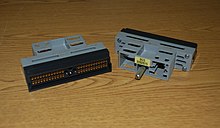Bus and Tag is an "IBM standard for a computer peripheral interface",[1] and was commonly used to connect their mainframe computers to peripheral devices such as line printers, disk storage, magnetic tape drives and IBM 3270 display controllers. The technology[2] uses two[a] sets of thick, multi-connector copper cables, one[b] set, carrying data, called the bus, and the other set, carrying control information, called the tag.[3]
Bus and Tag cables are "daisy chained"; and one interface can attach up to eight peripheral control units. The last control unit in the chain must have a terminator plug. Each control unit can attach a maximum number of devices, "sixteen is a typical number."[4] There is an architectural limit of 256 devices per channel, and initially a limitation of 200 feet (61 m), later extended to 400 feet (120 m), between the mainframe and the control unit.[5] Bus and Tag channels handle data rates up to 4.5 MB per second.[6] Only one device can transfer data at a time.[5]
Bus and Tag architecture was also used by other computer manufacturers to attach IBM peripherals to their systems. It was later published by the US National Technical Information Service (NTIS) as FIPS PUB 60-1, I/O Channel Interface.[7]
Bus and Tag was introduced with System/360 in 1964, and was also used with System/370. With the introduction of serial, fiber optic ESCON in the 1990s Bus and Tag channels were re-christened "parallel channels", and were gradually superseded. "Parallel channels are not available on the newest mainframes and are slowly being displaced on older systems."[4] Equipment is available to allow connection of older devices using Bus and Tag to mainframe FICON[8] or ESCON channels.
https://en.wikipedia.org/wiki/Bus_and_Tag

No comments:
Post a Comment